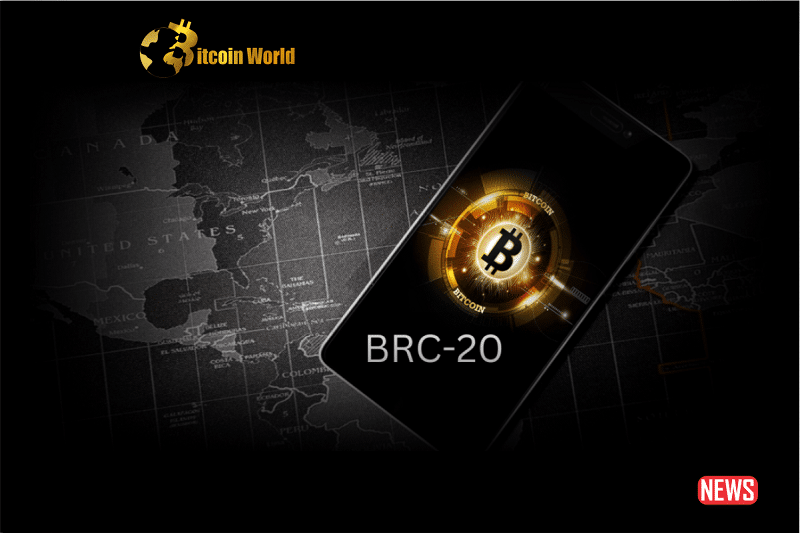Bitcoin, the king of cryptocurrencies, is facing a bit of a traffic jam! While its popularity is usually a cause for celebration, the recent surge in activity has led to something less desirable: increased network congestion and soaring transaction fees. Think of it like rush hour on a digital highway – everyone wants to get through, but the lanes are getting crowded.
Why the Bitcoin Bottleneck? The BRC-20 Buzz
So, what’s causing this digital gridlock? The answer lies in the rise of BRC-20 memecoins. These tokens, unlike those on platforms like Ethereum, operate directly on the Bitcoin blockchain without using smart contracts. Imagine them as a new type of vehicle suddenly appearing on our Bitcoin highway, adding to the already busy flow. CryptoQuant’s recent report highlights that the minting frenzy around these BRC-20 tokens is a major contributor to the increased demand for block space.
The Price of Popularity: Soaring Bitcoin Transaction Fees
This increased demand has a direct impact on your wallet. The cost of sending Bitcoin has jumped significantly. Here’s a snapshot of what’s been happening:
- Peak Fees: On May 9th, the average Bitcoin transaction fee hit a high of $29.
- Bitinfocharts Data: This source shows a similar spike, with average fees reaching $31 on May 8th, a considerable jump from around $19 the previous day.
- Miner Windfall: Interestingly, on May 8th, the total fees earned per block actually exceeded the block subsidy reward (6.25 BTC) for the first time since 2017! This means miners are earning more from transaction fees than from the newly minted Bitcoin.

More Transactions, More Waiting: A Backlog Building Up
Despite the higher costs, people are still using the Bitcoin network. In fact, the number of Bitcoin transactions has reached new heights:
- Record Transactions: Bitinfocharts recorded a peak of 534,000 Bitcoin transactions on May 9th. Some raw data even suggests higher spikes exceeding 600,000 daily transactions this month.
- Full Blocks: Blockchain.com confirms that the average transactions per block are at an all-time high of 3,778.
However, this high activity comes with a downside. According to Mempool Space, there’s a backlog of around 400,000 unconfirmed transactions. Think of it as a long queue at the toll booth – your transaction might take longer to process, and you might need to pay a higher fee to jump the line.
BRC-20 and Ordinals: Network Spam or Innovation?
The influx of BRC-20 tokens and Ordinals (a system for inscribing data onto individual satoshis, the smallest unit of Bitcoin) has sparked debate. Bitcoin core developers are reportedly considering taking action against them, viewing them as a form of network spam. The numbers are significant: ordinal inscriptions have almost doubled from 2.5 million to 4.78 million in just over a week. This rapid growth is undoubtedly contributing to the congestion.
Silver Lining for Miners: Increased Profitability
While users might be feeling the pinch of higher fees, it’s been a profitable period for Bitcoin miners. Since the beginning of the month, profitability, also known as hash price, has surged by an impressive 66%. On May 9th, the total market capitalization of BRC-20 tokens even surpassed the $1 billion mark, showcasing their significant impact on the Bitcoin ecosystem.
The Million-Dollar Question: Can Bitcoin Scale?
The recent surge in demand throws the spotlight back on a long-standing challenge for Bitcoin: scalability. Can the network handle a large volume of transactions efficiently and affordably? This isn’t a new problem, but the popularity of BRC-20 tokens has amplified the issue. While developers are exploring potential solutions and even considering actions against BRC-20, the long-term impact on network congestion and fees remains to be seen.
What Does This Mean for You? Actionable Insights
So, what can you do amidst this Bitcoin traffic jam?
- Be Patient: Transaction times might be longer than usual. If speed isn’t critical, you might consider waiting for periods of lower network activity.
- Consider Fee Adjustments: Most wallets allow you to adjust the transaction fee. Lower fees mean longer confirmation times, while higher fees prioritize your transaction.
- Stay Informed: Keep an eye on network congestion levels using tools like Mempool Space to make informed decisions about when to transact.
- Explore Layer-2 Solutions: Solutions like the Lightning Network offer faster and cheaper Bitcoin transactions for smaller amounts.
Looking Ahead: Navigating the Bitcoin Highway
Bitcoin’s current situation highlights the ongoing tension between its increasing popularity and its inherent limitations in handling a massive influx of transactions. The rise of BRC-20 tokens has acted as a stress test, revealing both the network’s resilience and its vulnerabilities. While the debate continues about the long-term role of these tokens and the potential for developer intervention, one thing is clear: the conversation around Bitcoin scalability and transaction fees is far from over. The coming months will be crucial in determining how the Bitcoin network adapts and evolves to accommodate the growing demands of its users and the innovative, sometimes disruptive, forces within its ecosystem.
Disclaimer: The information provided is not trading advice, Bitcoinworld.co.in holds no liability for any investments made based on the information provided on this page. We strongly recommend independent research and/or consultation with a qualified professional before making any investment decisions.


